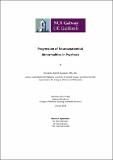| dc.description.abstract | Background: Structural brain changes and their cross-sectional relationships with clinical and functional measures have been demonstrated several times using magnetic resonance imaging at the onset of first-episode of psychosis (FEP) (Vita et al. 2006; Dazzan et al. 2012). However, few studies have carried out longitudinal analyses to clarify the extent and location of progressive changes and their associations over time and thus, findings in this area remain unclear. We investigated the progressive profile of ventricular and cortico-subcortical regions over a 3-year period in individuals following FEP compared with healthy controls (HC), and whether these progressive neuroanatomical changes were related to a number of clinical factors including severity of symptoms, antipsychotic medications and level of functioning. In order to choose an optimal tool to fully elucidate these neuroanatomical changes, the performance of various brain segmentation techniques were compared in terms of their anatomical accuracy, consistency and labour intensity.
Methods: For the comparative study of segmentation techniques, high resolution 1.5 Tesla T1-weighted MR images were obtained from 177 patients with major psychiatric disorders and 104 HCs. The relative consistency (partial correlation), absolute agreement (intraclass correlation coefficient (ICC) and potential technique bias (Bland-Altman plots) of each technique was compared with manual segmentation.
The studies (2 and 3) focusing on progressive neuroanatomical changes after FEP, similarly employed 1.5T T1-weighted MR images from 28 FEP patients and 28 HCs at baseline and 3-year follow-up. The longitudinal FreeSurfer pipeline (v.5.3.0) was used for regional volumetric analyses and cortical reconstructions by creating an unbiased anatomical template for improved sensitivity to detecting subtle changes over time. Repeated-measures ANCOVA and vertex-wise linear regression analyses were used to compare progressive changes in relation to subcortical structures/ventricles and thickness across the cortical mantle, respectively, between groups. Independent group analyses of covariance was used to compare rates of thickness change of the abnormal cortical regions (ROI). Partial correlations were used to determine associations of progressive neuroanatomical change with clinical and functional characteristics. Age, gender and intracranial volume (only in the case of volume) were included as covariates.
Results: In relation to the segmentation techniques, all yielded high correlations and moderate ICC’s relative to manual segmentation for the caudate. For the hippocampus, stereology yielded good consistency and ICC, whereas automated and semi-automated techniques yielded poor ICC and moderate consistency. Bias was least using stereology for segmentation of the hippocampus and using FreeSurfer for segmentation of the caudate.
In the analyses relating to progressive changes after FEP, a significant group by time interaction was found indicating progressively reduced volume of the caudate, putamen and thalamus in FEP patients relative to controls, with a trend for increased lateral ventricular volume more prominent on the right. Additionally, in FEP patients relative to HCs, there was a significantly increased rate of cortical thinning at a mean difference of 0.844% [95% CI (0.095, 1.593)] (Fig.4.3A) in the left lateral orbitofrontal region (LLOFR) over the 3-year period. We observed further that increasing lateral ventricular volume over time was associated with worsening negative symptoms and poorer global assessment of functioning over time.
Conclusions: In a typical neuropsychiatric MRI dataset, automated segmentation techniques provide good accuracy for an easy-to-segment structure such as the caudate, whereas for the hippocampus, a reasonable correlation with volume but poor absolute agreement was demonstrated. This indicates manual or stereological volume estimation should be considered for studies that require high levels of precision such as those with small sample size. This finding should inform the field especially in decision making on each type of segmentation technique to use especially for the now standard, large-scale brain morphometric studies ongoing in the field of neuropsychiatry.
Our results from the studies (2 and 3) focusing on FEP and MRI techniques utilised in study 1 demonstrate existence of localised progressive cortical thinning in the LLOFR characterised by volume deficits in the dorsal striatum, thalamic regions and right lateral ventricular enlargement across the psychosis phenotype after the early years following the first presentation of illness. This is suggestive of a structural disturbance in the subnetwork of the cortico-striato-thalamo-cortical circuitry in a progressive manner after FEP. Furthermore, increasing ventricular volumes are neuroanatomical markers of poorer clinical outcome. These findings lend weight to the evidence of early progressive brain changes in psychotic disorders and thus, this knowledge could potentially contribute to the identification of imaging biomarkers for timely intervention. | en_IE |


